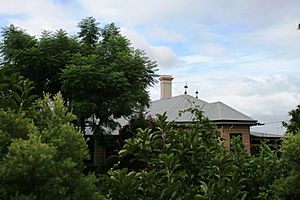Ralahyne facts for kids
Quick facts for kids Ralahyne |
|
|---|---|

Ralahyne, 2009
|
|
| Location | 40 Enderley Road, Clayfield, City of Brisbane, Queensland, Australia |
| Design period | 1870s - 1890s (late 19th century) |
| Built | 1888, 1904 |
| Architect | George Henry Male Addison, Hall and Dods |
| Official name: Ralahyne, East View, Huntington, Koojarewon | |
| Type | state heritage (landscape, built) |
| Designated | 21 October 1992 |
| Reference no. | 600182 |
| Significant period | 1880s, 1900s, 1920s (fabric) 1880s (historical) |
| Significant components | garden/grounds, residential accommodation - main house, service wing, courtyard, ballroom |
| Lua error in Module:Location_map at line 420: attempt to index field 'wikibase' (a nil value). | |
Ralahyne is a beautiful old house in Clayfield, Brisbane, Australia. It's a special place because it's listed on the Queensland Heritage Register. This means it's an important part of history and needs to be protected.
The house was designed by famous architects. George Henry Male Addison first designed it in 1888. Later, in 1904, the firm Hall and Dods added more to it. Over the years, Ralahyne has been known by other names too, like East View, Huntington, and Koojarewon.
The Story of Ralahyne
Ralahyne was built in 1888. It was made for Robert Gray, who was an important government official at the time. Before Ralahyne, there was a smaller, four-room house on the same land. George HM Addison, a well-known architect, designed this new, larger home.
The property was quite big, about 3.2 hectares (8 acres). It had different names over the years. First, it was called "East View" until 1892. Then, it became Koojarewon until 1900, and after that, Huntington. Robert Gray became the Commissioner of Railways in 1889. He passed away in 1902.
In 1902, Ada Laird bought the property. She lived there with her husband. In 1904, the Lairds hired the architecture firm Hall & Dods. They made big changes and additions to the house, costing over £1000. This was a lot of money back then!
Huntington was sold again in 1907 to Annie Millar. She renamed it Nowranie. The Millars lived there until 1918. Then, Ruby Winten bought it. In 1920, Henrietta Watson bought the property and gave it the name Ralahyne. The Watson family owned Ralahyne until 1985. Since then, parts of the large property have been divided and sold off.
What Ralahyne Looks Like
Ralahyne is a single-storey house made of timber. It has a sloped roof made of corrugated iron. The house is built so that its front faces east, looking out over its gardens. It's not directly facing the street.
The side of the house that faces the street has a long section. This part was once used for servants. It connects to the dining room at the eastern end. The dining room has a special bay window that sticks out.
The front of the house, facing east, has a wide verandah. This verandah has pretty cast-iron railings and decorative panels. Two parts of the house stick out onto the verandah. You can see them by their unique roof shapes.
On the northern side, there are two more sections that stick out. They are joined by another verandah, similar to the one at the front. At the back of the house, the ends of the northern and servant wings are connected by a verandah. This back verandah has shutters and was turned into a large ballroom. The ballroom has a domed ceiling and skylights, letting in natural light. This area forms a small courtyard, which used to be much larger.
Inside, most rooms have timber ceilings. The dining room has a special ceiling with a patterned design and carved beams. The drawing room has a beautiful fireplace made of white marble. It also has two fluted columns that mark the start of the bay window area. Throughout the house, you can see lots of impressive cedar woodwork, including the mantelpieces above the fireplaces.
Why Ralahyne is Special
Ralahyne was added to the Queensland Heritage Register on 21 October 1992. This means it's recognized as a very important historical place for several reasons:
- It shows how Queensland's history developed. Ralahyne was built during a time when people were very confident about the future. It shows the growth and success of public service in the 1880s.
- It's a great example of its type of building. It's a good example of the large houses built on the hills around Brisbane. It also shows how timber and iron were increasingly used for these homes.
- It's beautiful to look at. The house shows off how creative and beautiful timber can be, both on the outside and in the inside decorations.
- It shows great design and skill. Ralahyne demonstrates a high level of creative and technical skill from the time it was built.
- It's connected to important people. The house is linked to the work of famous architects GHM Addison and Robin Dods, who played a big part in Queensland's history.

